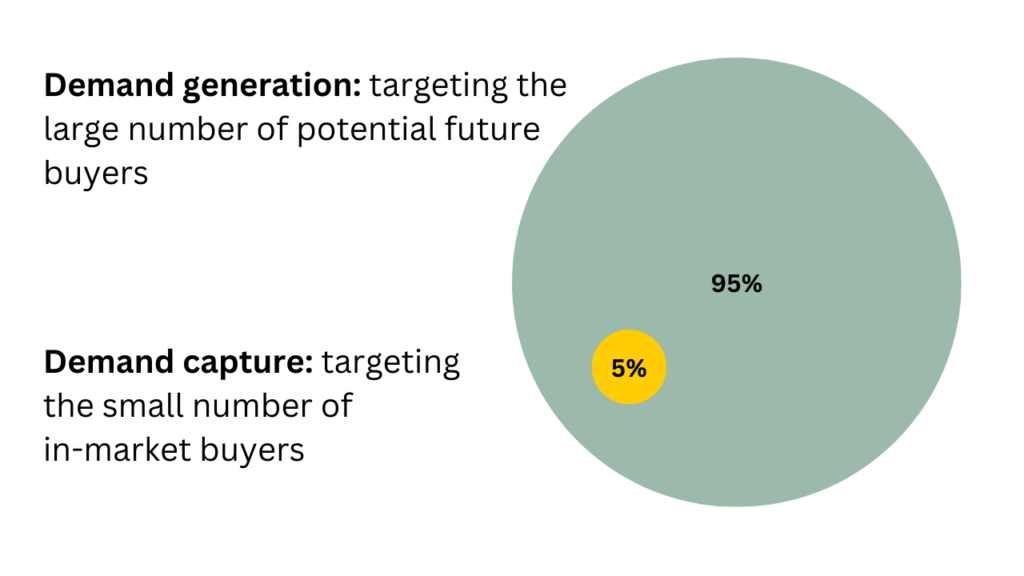
This article was written by our CMO Josua Fagerholm
Between 2009 to 2021 the world experienced economic growth. There was an increase in consumer confidence, spending, and borrowing. Demand was generally strong and investment capital plentiful.
This single fact impacted the way marketing was done more than anything else.
First, it made growth easier. For example, e-commerce penetration increased by around 50% in Finland in the last 5 years. This meant that a Finnish e-commerce brand could grow 8.45% per year just by following the overall market. A rising tide lifts all boats.
Second, it allowed many companies to only focus on demand capture because there was so much of it. This strategy was mostly enabled by Facebook and Google. They aggregated and sold demand through efficient algorithms and massive scale.

Third, it created inefficiencies. Investment capital was widely available, and much of it was spent on unprofitable marketing. Companies without product-market fit were able to grow by spending on customer acquisition, despite having a product without enough real demand.

An abundance of investment capital helped drive up acquisition costs. Source: SimplicityDX
If there has ever been a period where marketing was “easy”, it was from 2009 to 2021.
Things changed in 2022
High inflation and interest rates, low consumer confidence, and less available capital. Now there are fewer buyers and companies have less money to spend on acquiring them.
This shift in demand has already been felt by most business-to-consumer (B2C) companies. Business-to-business (B2B) is likely to follow soon, if they haven’t already.
We don’t know how long this will last. We don’t know if this is the bottom. But it’s clear that profitable marketing and growth will be more difficult going forward.
At the same time, marketing is still necessary. Cutting down on all marketing is like borrowing from the future to pay for today. Competitors that keep advertising will grab market share, which may prove difficult or expensive to regain. It’s a risky strategy.
New rules
Companies that want profitable growth in this new environment will need to do one or two things.
First, companies must start generating their own demand. Many companies’ entire growth marketing strategies were focused on demand capture, e.g. through brand search ads. When demand decreases and/or costs go up, this doesn’t work anymore. New strategies are needed, and the fact is that many companies are unprepared for this. They’ve never had to do it.

It might seem counterintuitive, but demand capture can actually be more expensive than demand generation. Advertisers are willing to pay a premium (for example, a higher cost per click) when targeting people with high buying intent. Demand generation is more uncertain and difficult, but it can be cheaper in the end.
Second, companies must capture market share. This is the only way to grow in a market that is stagnating or declining. This kind of “headwind growth” is much more difficult than riding the wave of a growing market.
This new pressure for demand generation and market share capture has big implications for marketing.
The impact on marketing
Many of the old targets and benchmarks are no longer relevant. And the economics of performance marketing will no longer work for some companies.
Attribution is no longer sufficient for measuring performance, because of the shift from demand capture to demand generation. It must be combined with other tools that can better account for long-term effects: qualitative customer insights, media mix modeling, etc.

Companies must reduce overhead and inefficient marketing spend. And they must do this without cutting the things that are actually working and driving growth. Experimentation (e.g. deprivation tests) and thorough analysis are needed to distinguish between the two.
Companies must become more selective. Previously it was possible to drive traffic or create awareness, with little-to-no thought on how (or if) it would convert. Now companies must figure out who their best and most profitable customers are, and focus relentlessly on marketing to them.
And finally, marketing must become better. With all these external factors working against it, marketing must be more creative, attention-grabbing, and engaging than ever before.
A new reality
This is not a trend among the rest. It’s not about figuring out how to leverage TikTok or Chat GPT in your marketing.
It’s about the need for marketing that drives real business outcomes. Marketing that is profitable (within a reasonable time frame).
In other words, marketing must start to sell, again. This is definitely not a new or original insight. Decades ago, David Ogilyv proclaimed that “if it doesn’t sell, it isn’t creative.”
We may be headed for a recession. It wouldn’t be the first. But it is the first recession for many of today’s consumers and brands. And it’s the first recession in today’s hypercompetitive, fast-moving, increasingly complex, and connected world.
In a way, everything has changed. In a way, nothing has changed.
It’s a new era for digital marketing.
